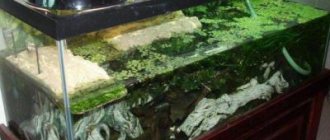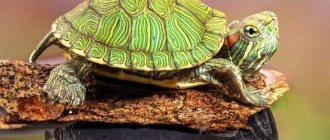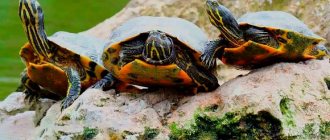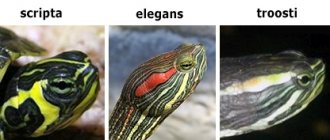Pet lovers often keep a red-eared turtle as a pet. Unfortunately, few people know what kind of care this reptile requires, and therefore many representatives of the species die due to improper living conditions. If this wonderful animal is provided with everything necessary for a comfortable life, then it will delight its owners for many years.
The lifespan of a pet depends on environmental conditions
Conditions at home
Due to its unpretentiousness, omnivorous nature and tolerance to room temperatures, the musky turtle is a favorite inhabitant of home terrariums.
Although when caught, the animal shows a rather warlike character, biting and breaking free, but after some time spent in captivity, it becomes quite peaceful. An additional method of protection for this reptile is a yellowish, sharp-smelling secretion secreted from a gland located under the shell. Its lifespan in captivity is more than 20 years.
Specialized publications indicate the need to equip a shallow reservoir with a water height of no more than 15 cm, but practice has shown that this is not at all necessary.
A fairly well-known turtle breeder, Gerhard Müller, states that he kept his musk turtles in aquaterrariums with a water level of about half a meter, and in natural conditions they usually live at a depth of up to 85 cm. Some difficulties with adaptation arose only with individuals received from other terrarium keepers, however , after a short time, they also adapted.
It is quite difficult to recreate the muddy bottom to which musk turtles are accustomed in their natural habitat, so in home aquariums washed river sand, strong branches, stones, decorative roots, as well as green spaces are used, which improve the condition of the water and serve as additional food for the reptiles.
Common musk turtles are big messy creatures, so be prepared to either invest in a fairly powerful filter or change the water every few days. Pay attention to the fact that all accumulated droppings and dirt are removed along with the sucked water, and that the fresh water poured in is the same temperature as the old one. It is best to use settled water, from which all the chlorine has already been removed. It is recommended to maintain the tank temperature within 22-30⁰ C, and the ambient temperature should fluctuate approximately within the same range.
Try to diversify your turtle's diet as much as possible. It should consist of:
- Dry food;
- Live food (snails, tadpoles, frozen shrimp, lean veal, earthworms, bloodworms, small fish);
- Plant foods (lettuce, cabbage, duckweed).
During the period of egg laying inside the aquaterarium, it is necessary to separate the artificial shore from the water part; for this, an inclined glass plate is installed. If this is not available, you can use a homemade sand mound or ordinary brick. On a bank adapted for laying eggs, it is necessary to install a ditch with washed river sand.
Central European breeders often release musk turtles into small outdoor ponds during the summer, so the animals spend time almost in their natural habitat.
If you have the opportunity to provide turtles with a large aquaterrarium and eliminate the moment of competition while eating, then this type of reptile can be kept in small groups.
If, under terrarium conditions, you do not arrange “wintering” for musk turtles, then the males will strive to mate with females all year, alternating periods of activity with periods of rest. However, the peak of “courtship” still occurs on warm, sunny spring and summer days if kept outdoors. Common musk turtles do not have any mating dance, and the mating process takes from 60 minutes to a day.
Caring for baby turtles
Adding a new pet to the family is always a joyful event that requires a responsible approach on the part of the owner. Caring for newborn turtles falls entirely on the shoulders of the owner, since the maternal instinct in turtles is not developed. Despite having a strong shell, small turtles are incredibly delicate, so any damage to the outside can negatively affect their health. There is a high mortality rate among sea turtle hatchlings, so if the baby shows any signs of a change in appearance or behavior, you should take it to a veterinarian.
Small sea turtles are so shy that death can result from severe fright. It is not recommended to pick up the cubs or knock on the glass of the aquarium. After arriving at a new place, the pet should get used to it, so for the first few days it should not be disturbed. If you have not previously dealt with turtles, you should study the features of their anatomical structure. On the yellow belly of the turtle, called the plastron, there is a small pouch that contains nutrients for the baby. It disappears as the turtle grows up, this usually happens in the second month, when the turtle begins to eat fully. Baby sea turtles are more susceptible to waterborne diseases, so it should not stagnate in the aquarium for more than two days. The water temperature should not be 5˚C higher than the norm, which should be taken into account when keeping adult turtles, that is, on average it is 26-27˚C.
What to feed a freshwater turtle
Having dealt with the question of how to care for a turtle, it’s time to find out what reptiles eat. The diet largely depends on the age of the animal - very young children receive all the necessary nutrients from a special gall sac, which is located on the plastron. While the cub is feeding on the gall sac, it does not need additional feeding. Young reptiles can be fed small crustaceans, vegetables and, of course, specialized food with calcium supplements. During this period, the shell is actively growing, and the lack of the main element for its structure can negatively affect the health of the turtle.
What do aquatic turtles eat? Plant food, animal food and artificial food. At the same time, food from a pet store should make up about 50% of the total diet. The diet should be varied - lettuce, dandelions, clover, algae, mussels, shrimp, snails, raw fish and chicken. The portion depends on the animal's appetite. Young animals should eat at least once a day. Adults can be fed once every 2-3 days.
Hibernation period
During the winter months, the American yellow-bellied turtle can hibernate, although it does not need to. Moreover, everything possible must be done to prevent this from happening. It is strictly forbidden to stimulate your pet to hibernate.
This may be unsafe for several reasons:
- the owner may not have enough knowledge to properly care for the animal during this period;
- it is difficult to create conditions suitable for the reptile to hibernate normally;
- young and sick animals may be too weak to survive such a difficult period.
Animals that hibernate in the wild burrow into a layer of leaves and mud at the bottom of a shallow body of water. During hibernation, they do not surface, absorbing all the necessary oxygen through membranes in the mouth, pharynx and cloaca.
It is very important that the depth of the reservoir is optimal. The water in it should not be too cold and at the same time have sufficient oxygen content. It is almost impossible to recreate such conditions in a home aquaterrarium.
Turtles tend to hibernate
To prevent your pet from hibernating, you need to maintain the water temperature around 24-26°C. Colder water will remind the animal of winter.
Keeping a red-eared slider is quite a challenging task. She needs a large swimming aquarium with a dry island where the reptile can bask under a lamp. The reptile has an aggressive character and loves to bite. But still, this is a beautiful animal that can become a favorite of the whole family.
In this video you will learn more about the turtle:
Land turtles
Living conditions, feeding and bathing
For land turtles, a terrarium is usually prepared, but if one is not available, an ordinary cardboard box or plastic container will do.
The bottom of the container is covered with clean hay or sawdust. It is not recommended to use soil or sand. In order for the turtle to periodically grind down its claws, it is worth placing several large stones in the terrarium.
The terrarium must be equipped with an infrared heater or incandescent lamp. To prevent the turtle from suffering from lack of sunlight, you should install an ultraviolet lamp.
Turtles do not really like attention to them and often hide. Therefore, you can build a “house” for them. You can make it from a flower pot cut lengthwise, half of which will become a shelter for your pet.
Land turtles love to eat vegetables (mashed carrots, zucchini), fruits (apples and others), dandelions and lettuce. Dandelions can be dried for the winter.
Turtles “drink” through their skin, so they should be bathed at least once a week. For this, the water temperature should be about +32C, and its level should be up to the middle of the shell.
Land turtles need to be cared for especially carefully during their molt. To do this, add baking soda to the water while bathing (one teaspoon per liter of water). During molting, the pet bathes in this solution no more than twice. Do not lubricate the shell with lotions or oils. They only clog the pores on the skin, but have practically no benefit.
In summer, at temperatures above +20C, land turtles can be walked. A green lawn with dandelions and clover growing is suitable for this.
Having created all the necessary conditions for your pet, he will feel good and comfortable throughout his many tortoise years. Do not forget that an animal is still not a toy, but a creature that needs care and attention.
The amazing world of sea turtles
Scientists are still searching for an answer to the question of the origin of turtles. From the myth it is known that the globe was supported by a giant turtle, the ancestor of which remains unknown. A 220-million-year-long mystery remains unsolved—that’s how long turtles have inhabited planet Earth.
- Sea turtles have excellent memory and, after long journeys, can return to the place where they were born. This is due to their ability to navigate the Earth's magnetic field.
- 100 million years - this is exactly how much time has passed since the emergence of leatherback sea turtles, which are recognized as the oldest.
- Leatherback turtles are capable of living in waters more than a kilometer deep.
- Green turtles and turtles can weigh up to half a ton.
- In order to find a suitable place to lay eggs, turtles can swim 20 thousand kilometers.
- A female sea turtle can lay 1,000 eggs in one breeding season.
- Residents of a place near the Melaya River still believe that the turtle Manoi was the creator of the world.
- The leatherback turtle has the highest body temperature, which allows it to live in northern latitudes. However, to do this, she needs to constantly receive adequate nutrition, otherwise she will not tolerate such living conditions.
- When in danger, the turtle makes a sound reminiscent of the hissing of a Levantine viper.
- Sea turtles reach full maturity by age 30. Before this, they are considered cubs, incapable of reproduction.
- The smallest sea turtles do not exceed 75 centimeters in length.
- The largest leatherback turtle found on land weighed 960 kg. The length of the turtle turned out to be just as impressive – almost 3 meters. The discovery was made recently, and the male turtle cannot claim to be the largest. The real giant Archelon weighed about two tons, and the length and width of its shell were 4 meters.
- Leatherback turtles are recognized as the fastest, capable of moving at speeds of up to 35 km/h. This is almost 2.5 times the speed of the first car, invented in the mid-18th century. By the way, their running speed on land is also quite high - 10-15 km/hour. However, large turtles are not able to reach speeds of more than a kilometer per hour.
How to arrange housing for a turtle?
As a rule, red-eared turtles are kept at home. Its home is an aquarium, which has a small plot of land or an aquaterrarium. The shore or land for a sea turtle must be equipped with an accessible approach so that the animal can always climb onto it without obstacles.
The shore must be designed in such a way that the water flowing from the turtle cannot stagnate in it. An aquatic turtle must be able to dry out its shell. A heating lamp with a power of forty to sixty watts is installed at a height of twenty-five to thirty centimeters above the land area. It is prohibited to place the lamp below, as the turtle may overheat.
Caring for such a pet requires having a fairly large home. If the aquarium will contain several animals, its dimensions must be appropriate.
Caring for large individuals will be much more difficult, since their maintenance will require housing exceeding several hundred liters. When buying an aquarium for a turtle, it is worth remembering that some breeds can grow up to 18-28 centimeters.
A domestic turtle can be kept in either a glass or plastic aquaterrarium, in which an aquarium filter and a heater must be installed, corresponding in power to the volume of infused water. Caring for a red-eared turtle requires compliance with the correct temperature conditions: the optimal water temperature is 26 degrees and the air temperature on the shore is at least thirty degrees.
For aquatic turtles, it is necessary to use an aquaterrarium, and in no case should they be kept on free grazing - that is, on the floor or in other “natural” conditions.
For normal life and growth of a turtle, an ultraviolet lamp is required. Such a device will ensure proper care for it, since ultraviolet radiation replaces sunlight, which promotes the absorption of calcium in the turtle. It is best to choose a lamp with five percent UVB.
The pet turtle should be kept in an aquaterrarium throughout the day. Only when feeding and cleaning her house is the pet placed in another container with water. To ensure proper care for the turtle, you should not let it go on the floor, as the animal may get sick or injured.
Content Features
The red-eared turtle is quite demanding in terms of living conditions. When purchasing such a pet, you need to understand that the size of the aquarium does not have any effect on the size of the reptile. Even in a small container the animal will grow, but will become weak and sick.
To provide your reptile with comfortable living conditions, you must purchase the following:
- aquarium for turtles with a volume of 150 l;
- 100 Watt water heater;
- external filter;
- ultraviolet lamp for aquatic turtles with UVB 10%;
- heating lamp;
- lighting lamp;
- thermometer;
- sushi element.
In addition to all of the above, you should choose a strong table or cabinet, since the weight of all the equipment is quite high.
The aquarium consists of a number of elements
How long does the red ear live and where does it live?
This type of turtle can rightfully be considered a long-liver. In favorable conditions, life expectancy is 40 years. An interesting fact is that the red-eared turtle has a high level of intelligence, not typical of other reptiles. These animals are very sensitive to vibrations and their behavior can warn of an impending earthquake or storm. When choosing food, the red-eared turtle first focuses on the color, and only then on the smell and taste of the object.
These reptiles are widespread in nature. They can be found in their natural environment in Central and South America, Israel, South Africa, Spain and even Great Britain. But in Australia, this species is officially recognized as a pest, since it destroys local endemics. The red ear lives in shallow ponds and lakes, and in other bodies of water with swampy shores.
Keeping this exotic animal turns out to be much more difficult than initially thought. These turtles spend most of their time in the water, although they need land. For one adult, an aquaterrarium with a volume of 120-150 liters will be comfortable, while land should occupy no more than 25% of the total area. On the improvised bank, special soil or crushed stone should be poured, making a gentle rise. The turtle's shell must fit completely in the water so that the animal can easily roll over onto its back and back.
For this type of amphibian, the optimal temperature is 25-30 degrees Celsius. When the temperature drops to 20 degrees, hibernation may occur in red-eared turtles. The water in the aquarium is changed as needed, at least once a month. In order for the turtle to be healthy, it also needs to be provided with portioned irradiation with an ultraviolet lamp.
Do you need neighbors?
The behavior of red-eared turtles in relation to other underwater inhabitants and relatives cannot be called friendly. Reptiles tend to enter into conflicts with each other, and pugnacity especially manifests itself in adulthood. Given this temperament, it is recommended to keep turtles separately from relatives, or provide pets with a spacious terrarium with partitions.
Tips for keeping two or more reptiles in one container:
- Pets must be the same size and age.
- You cannot keep two males in a terrarium.
- Each individual should have personal space and a rest area.
It is important to note that it is not recommended to keep frogs, lizards and snakes together with turtles, as these creatures are perceived by reptiles as food.
Diseases
Despite the endurance and resilience of red-eared turtles, sometimes due to errors in keeping the reptiles get sick and die. Knowledge about common turtle ailments and treatment methods will help you avoid such consequences:
- Pneumonia - the disease develops due to being kept in cold water or lack of food. Symptoms include hoarse breathing, lethargy, weakness and pallor of the mucous membranes. Treatment is carried out using an injection of Baytril 2.5% - 0.4 ml/kg into the brachial muscle.
- Bone ailments - if white spots on the shell and detachments are detected in a red-eared turtle, we can conclude that there is a fungal infection. Pets are treated with Clotrimazole ointment, treating damaged areas.
- Lack of calcium - with this problem, reptiles' shell peels off. The deficiency can be eliminated by giving pets small fish with bones and calcium supplements.
Red-eared turtles are funny and interesting pets that, instead of trouble, bring only joy and tenderness to their owners. Considering the attractiveness, endurance and unpretentiousness of reptiles, even an inexperienced owner will be able to raise and reproduce turtles at home, following the rules and recommendations for care.
Habitat in nature
The red-eared turtle received its original name due to its distinctive external feature: two scarlet-orange spots stretch from the eyes to the neck of the reptile. The turtle’s second nickname is the yellow-bellied turtle, due to the fact that the creature’s abdominal shield is painted bright yellow.
The habitat of the red-eared slider in nature is America, so the variety is often called “American”. Reptiles live near rivers and cannot live without water, but land plays a significant role in nature for the red-eared slider. The lifespan of these reptiles is 30-40 years. Having acquired an exotic pet, the owner should know the nuances of keeping red-eared turtles at home so that the pet lives a long life.
Pond slider
It is called so because of the pair of yellow, orange or red spots on the head - “ears”, located on the sides of the head. The length of the carapace ranges from 11 cm to 60 cm, depending on age. The shell has a rounded-oval streamlined shape, covered with horn-like plates-scutes, on the limbs the fingers are connected by membranes, the fingers themselves end in sharp claws. The head is covered with soft skin.
Let's start from the beginning - with the “house”. To keep freshwater turtles, a horizontal aquaterrarium is required, since area is more important to them than height. The aqua terrarium should be spacious enough for the turtle to move freely in it. Its size should depend on the size of the animal. The water part should be about 2/3 of the area of the terrarium, its depth depends on the size of the turtles. The shore of the pool should be flat, as in natural conditions, so that animals can easily get out of the water.
The main factors for successfully keeping reptiles at home: lighting, temperature, ultraviolet light, water filtration.
One of the most important factors is lighting. It is practically impossible to over-light a terrarium, and saving on lighting is unacceptable. Turtles are children of the sun. Turtles living in home aquaterrariums need additional ultraviolet irradiation, since a lack of ultraviolet radiation causes various diseases. There are now many varieties of imported UV lamps on sale with different powers and different sizes, designed specifically for reptiles.
The water in the terrarium must be filtered through a relatively large and powerful filter. However, even with constant filtration, it is necessary to do a complete or partial change of water.
Every terrarium must have good ventilation. The only thing is that you should not confuse ventilation with drafts. Reptiles are afraid of drafts and are susceptible to colds. The temperature of water and air should be approximately equal.
Young turtles need to be fed once a day, and adult turtles once every few days. You need to feed turtles either ready-made food from imports, or homemade food, but with the addition of vitamin and mineral supplements. If you decide to feed your turtle food prepared at home, then it should consist of: lean sea fish, shrimp, squid, hamarus, bloodworms, mollusks, small aquarium snails, etc.
Reproduction
In red-eared turtles, reproduction occurs in the spring. Males are capable of reproducing from the age of 4, females from the age of five. To see how reptiles lay eggs, the owner should prepare a breeding container:
- The water level should not exceed 10 cm.
- A container is installed on an island of land where turtles lay their eggs.
It is important to note that only a pair of turtles of the opposite sex should be present in the terrarium during the breeding season, otherwise the males will fight. The turtles mate in an interesting way: the male swims up to the female, tickles her with his claws and pokes her with her muzzle.
After mating of the red-eared turtles has occurred and the expectant mother has laid eggs in a dug hole, the container with the offspring is transferred to the incubator. The optimal temperature is 27-30C, and it is noted that at 30C females are born, at 27C - males. After about 2 months, the turtles are born, but the babies cannot be released to adult reptiles, since yellow-bellied pets do not shine with parental love and can attack.
How to determine gender
In order for the breeding of red-eared turtles at home to be successful, every owner must know how to calculate the sex of the pet. To do this, the appearance of reptiles is compared, identifying differences that will indicate gender.
To understand how to find out the gender of a red-eared turtle, you need to be able to find the differences between a male and a female:
- Females are slightly larger than males and have a rounded head shape. Males have an elongated head.
- Males have a depression on the abdomen; girls do not have such a depression. The shell of male representatives is elongated, while that of females is rounded.
- Female turtles have short claws, while males have long and sharp claws.
- In male representatives, the tail is wider and thicker, and the cloaca is located at a distance from the shell. In girls, the cloaca is star-shaped and located close to the shell.
How to determine the sex of a red-eared turtle
How to find out age
Unfortunately, sometimes even store salespeople are unable to accurately tell the age of a red-eared turtle, so owners have to deal with this issue on their own. The following data will help you find out the age of a red-eared turtle:
- 2 years – females 8-9 cm, males – 7-8 cm.
- 3 years – females 10-14 cm, males – 8-10 cm.
- 4 years – females 13-16 cm, males – 12-14 cm.
In addition to calculating age based on pet size, you can find out the approximate number of years in the following way:
- Shell color - in young turtles the coating is green. After 4 years of life, the shell begins to darken; in older reptiles the cover is almost black.
- Rings – rings are formed on the shell when reptiles reach one year, 2-3 rings are added every six months. After 4 years of life, the ring appears once a year. By counting the number of rings, you can roughly estimate the age of the turtle.
Water purification in an aquaterrarium
Aquatic turtles primarily feed on highly perishable food. In addition, the excretions of these animals significantly pollute the water. Previously, the owners of these pets had to change the water several times a week. However, now caring for them has become much easier thanks to the emergence of a variety of modern filters.
Aquaterrariums for turtles are a magnificent decorative element that can decorate almost any interior.
In small aquariums with small specimens, conventional internal filters equipped with a sponge are installed. Many models of such filters are suitable for small bodies of water. They do an excellent job with fairly small and large particles of dirt.
Recently, special devices that simplify the care of aquaterrariums, such as “biological filters,” have become popular. They use special bacteria that are used to remove nitrogen compounds.
Pet stores also sell specialized fillers made by foreign manufacturers. Such filters help keep water clean for a long time and do not allow bacteria to grow in it.
How to handle it correctly
When a person wants to pick up a turtle, it is recommended to remember that it is wet and slippery. She doesn’t like these manipulations, so she hisses, can scratch, since she has large claws, and is even capable of biting. Therefore, the pet must be held with both hands at the same time.
After spending time with the reptile, you need to wash your hands with hygiene products, since it is a waterfowl and has its own microflora. It is necessary to ensure that the food and water in the container are fresh. Turtles spread salmonella. Therefore, it is forbidden to wash the reptile in the kitchen sink and its accessories too.
water turtle
What to look for when buying an aquatic turtle:
- Behavior: coordination of movements, activity.
- Appearance: the shell must be of the correct shape with even, adjacent shields. There should be no damage or unwanted stains on it.
- The oral mucosa in healthy reptiles is light pink in color, without whitishness or plaque.
- The turtle's breathing should be silent.
- There should be no discharge from the nose and mouth.
Water turtle at home
To keep a turtle you need an aquarium, the volume of which depends on the size of the reptile. Its width should be twice as large as its height. When choosing an aquarium, keep in mind that small turtles grow quickly. However, it is not worth purchasing it for “growth”. In a large aquarium, a small turtle will feel uncomfortable. It is best to first buy a small, inexpensive aquarium, and then replace it with a larger one.
Setting up an aquarium and caring for turtles
You should immediately pay attention to the fact that the plastic island is inconvenient. The turtles slide off it. It is best to choose a rough, gently sloping bank.
The land in the aquarium should occupy approximately one-fourth of the total area. It is necessary to leave at least thirty centimeters of space from it to the edge of the container. Otherwise the turtles may escape.
If you install a yellow incandescent lamp above the island, then the water in the aquarium does not need to be heated. The water should not heat up more than twenty-one degrees. It should be changed quite often to prevent a musty smell. This negatively affects the health of pets.
It is better to remove small turtles from the aquarium and place them in a warm and dry place. For example, in a box covered with a towel. Then they will grow and develop better.
Nutritional Features
Small turtles should be fed every day. As they grow older, the number of meals is reduced to once every three days. Sometimes turtles may refuse food, then they need to be fed with guppy fish.
The diet of aquatic turtles must include lean meat (beef, chicken, turkey) and chopped vegetables. It is recommended that adult reptiles be fed supplements containing microelements, calcium and vitamins necessary for the proper development and growth of an aquatic turtle.
Feeding
Omnivores that feed on a wide variety of foods. Variety is important to keep your turtle healthy.
You can feed: artificial food, food for aquarium fish, vegetables, aquarium plants, insects, fish, invertebrates.
In addition to variety, it is important to provide a balanced diet high in calcium. Like all wild animals that live indoors, there is a tendency to overeat.
Young turtles are mostly omnivores. But as they grow and mature, they become more and more herbivorous.
Omnivorousness means that the diet contains a large amount of protein, but in adult turtles it is much less.
Turtles of any age will prefer live prey or carrion, but should only be fed occasionally. It is also necessary to provide additional calcium for the normal formation and growth of the turtle's shell.
What to feed?
They eat almost everything, but the main food may well be artificial food for aquatic turtles, since there are many options and types. Their composition is specially selected to provide all the necessary substances for turtles. The high protein content of commercial feeds allows them to be fed in small portions.
To make feeding more balanced, add calcium and plant foods and your turtle will be quite happy.
Please note that commercial feeds most often already contain calcium additives; read the labels on the packaging.
Red-eared turtles require water to swallow because they do not produce saliva.
They can take food on land, but will drag it into the water to eat it. You can use this to your advantage and feed them in a separate container, so the water in the aquarium will remain clean for a longer time.
Feeding with plant foods
Fresh vegetables should always be given to your turtle, regardless of whether he shows interest in them or not. A good mix of vegetables contains essential fiber, calcium, vitamins A and K.
Aquarium plants can also be given, especially since they are similar to those that the turtle has in nature.
It is especially important to feed adult and old turtles with plant foods! Their diet should consist of 75% vegetables and aquarium plants.
It can be duckweed, riccia, ludwigia, hornwort, lettuce, pieces of cucumber and zucchini, boiled dandelion and nettle, clumps of filamentous algae.
Live food (guppies, snails)
Omnivores, they happily eat everything they can get their hands on. The turtle's victims will include insects, snails, small fish and worms, crickets, etc.
So the question of whether guppies and red-eared turtles can get along in the same aquarium is not at all worth it. The same can be said about any aquarium fish, even large ones can bite.
Despite the attractiveness and availability of such foods, they should be given in moderation.
It is better to feed special food for turtles, since they are balanced and do not tolerate diseases and parasites.
How much and how often should I feed?
A difficult question, since for the most part it depends on the size, age and the food you give.
Turtles up to one year old need to be fed artificial food daily, and you can also give plant food daily, even if she refuses. But a turtle older than a year can be fed every other day or even two. However, plant foods can again be fed more often.
The amount of food may also vary. Newly hatched turtles should receive more protein, approximately 50% of the total food.
Since most turtle foods contain about 40%, you can additionally feed fish such as guppies, insects, and earthworms.
For adult turtles, the percentage of artificial food is reduced to 10-25%, and the rest should be various plants.
Since the size, shape and composition of feed can vary significantly, you need to focus on what the manufacturer writes on the packaging.
Health
Improper feeding and care lead to various diseases. The main symptoms are:
- twisted shell;
- peeling;
- refusal of products;
- constantly closed eyes;
- inactivity.
To avoid the occurrence of illnesses, you should control what the turtle eats and how polluted the water is.
If any signs, wounds or swelling are detected, the reptile must be urgently shown to a specialist.











